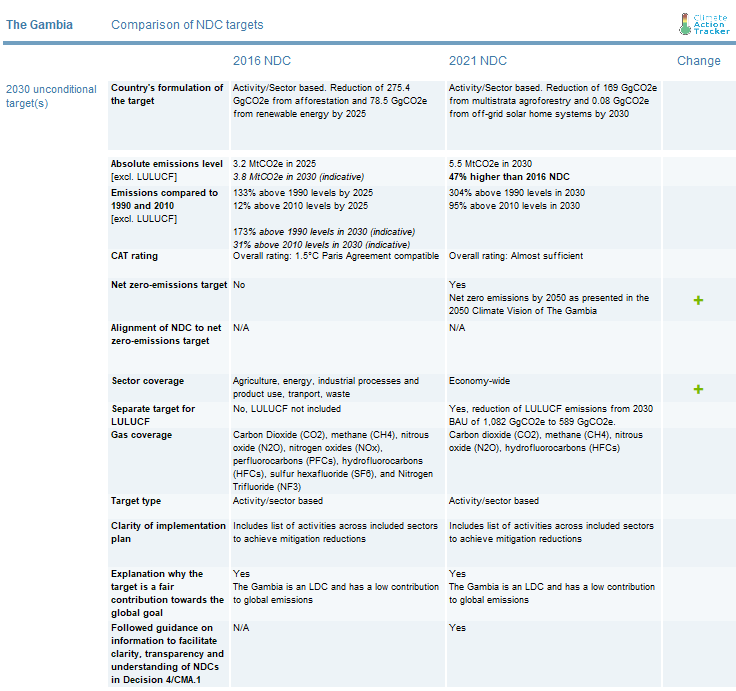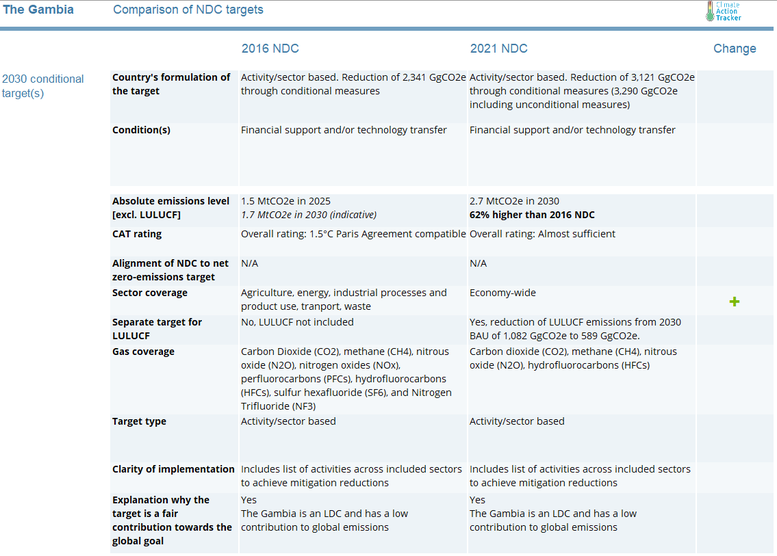CAT Climate Target Update Tracker
The Gambia
Summary
The Gambia submitted its Second NDC in September 2021. While The Gambia’s Second NDC is a progression from its first NDC in some ways, such as expanding sector coverage, the update does not lead to lower emissions than the first NDC.
The Gambia’s Second NDC uses a higher BAU estimate because of revised historical data, resulting in higher absolute target emissions. This changes the rating for its internationally supported target from “1.5°C Paris Agreement compatible” to “Almost sufficient”.
Further, activities considered unconditional on international support are expected to contribute less to reductions than in the first NDC. This does not change The Gambia’s fair share rating of “1.5°C Paris Agreement compatible” for its unconditional target; however, it does place its unconditional target above current policy projections. Overall, The Gambia’s rating changes from “1.5°C Paris Compatible” to “Almost sufficient”.
CAT analysis of the NDC

In September 2021, The Gambia submitted its Second NDC with revised mitigation targets and additional mitigation activities to meet those targets.
The two activities labeled unconditional are multistrata agroforestry (169 GgCO2e) and off-grid solar home systems (0.08 GgCO2e) . Based on the mitigation potential of these unconditional activities, the new target results in an absolute emissions level about 5.5 MtCO2e excl. LULUCF (6.4 MtCO2e incl. LULUCF) by 2030.
This is higher than the indicative unconditional target for 2030 in the First NDC (3.7 MtCO2e excl. LULUCF). Since we do not consider land use emissions, unconditional reductions under the Second NDC are essentially negligible under the CAT rating system. The Gambia’s unconditional target still meets its fair share contribution to limiting warming to 1.5°C. However, its updated unconditional target is now above our current policy projections for The Gambia, making it unlikely to drive action.
There are some improvements to architectural elements of the NDC. The Second NDC now includes land use emissions not previously covered. As land use accounted for almost a third of emissions in the base year 2010, this greatly expands covered emissions. The First NDC also only provided indicative 2030 targets, focusing instead on reductions in 2025. The Second NDC has shifted to 2030 targets.
The Second NDC also reiterates The Gambia’s aim to achieve net zero carbon emissions by 2050, as outlined in The 2050 Climate Vision of The Gambia. Our assessment of The Gambia’s net zero target will follow later.

The total emission reductions of conditional activities are higher in the Second NDC than in the first; however, the Second NDC results in higher absolute emissions due to revision of the BAU. The new conditional target results in an absolute emissions level of about 2.7 MtCO2e by 2030 (excl. LULUCF) (2.9 MtCO2e incl. LULUCF). This is higher than the indicative conditional target for 2030 in the First NDC (1.7 MtCO2e excl. LULUCF). We rate the new conditional target as “Almost sufficient”, downgraded from the 1.5˚C Compatible rating of the first NDC.
While the conditional target is well below our current policy projections, some of these activities could be more ambitious to drive action. The activity targeting 89 MW of utility-scale solar capacity by 2030 is already on track to be met by 2025, with an 80 MW unit scheduled to go online this year and a 70 MW unit planned for 2025. Two tenders for a further 150 MW solar plant were issued in 2020.

Assumptions
Emissions levels resulting from the targets
NDC conditional target values are calculated based on the stated sectoral target values in the Second NDC for 2030. Except for energy and LULUCF, the reductions indicated by the sectoral target values are in line with the mitigation potentials of the mitigation actions and their estimated impact in relation to the BAU. Since the reductions to reach the sectoral target values are in line with total reductions stated in the Second NDC, we use these values to estimate the target values and to exclude LULUCF.
Global Warming Potentials
The Gambia’s Second NDC does not indicate what global warming potentials (GWPs) were used, however, it says the BAU revision was based on the Third National Communication which uses GWPs from the IPCC’s Fourth Assessment Report (AR4). Therefore, we assume the BAU and the mitigation potentials of activities were reported using GWPs from AR4.
Links
Stay informed
Subscribe to our newsletter